By Jessa Kay Cruz, Senior Pollinator Conservation Specialist, The Xerces Society for Invertebrate Conservation
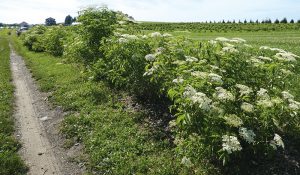
A hedgerow of blooming shrubs and perennials along a field border serves as habitat for beneficial insects. Photo courtesy Sarah Foltz Jordan
One of my favorite stories about pest control takes place on a small vegetable farm in western Idaho. I am conducting a site visit, consulting with the farmer, Lucas, about an upcoming habitat project. It’s fall, and many of his summer crops are done for the season. As we tour the farm, he shows me his carrots, onions and cilantro. He has finished harvesting these plants, but instead of terminating them immediately, he decided to let them bolt because I’d previously told him that the nectar-rich flowers of these plants are a favorite of parasitic wasps and other natural enemies.
From the bolting summer crops, we head over to look at his recently planted broccoli. He had noticed an aphid outbreak earlier and wants me to help him determine if the outbreak warrants spraying. As we start to scout, we see something strange. The aphids look dark-colored and desiccated, almost the same way they look after being sprayed. Closer examination with a hand-lens reveals what I suspected: they’ve been parasitized. Every single one of the aphids is dead. I tell him that those bolting crops must be doing their job, raising populations of parasitic wasps that are attacking the aphids on his broccoli. It’s a perfect system.
At work in this story is a pest-management strategy that has been getting a lot of attention lately, referred to as conservation biological control, conservation biocontrol, or simply CBC. The foundation of CBC is creating conditions on a farm that attract and support significant populations of beneficial insects. These beneficial insects, also known as “natural enemies,” attack crop pests like aphids and flea beetles by either eating them or parasitizing them.
Insects like syrphid flies, lacewings and lady beetles prey directly on crop pests; a single lady beetle can consume up to 5,000 aphids in its brief lifetime. Others, such as braconid wasps and tachinid flies, are parasitoids, laying their eggs on or inside the body of their host. Those eggs then hatch and the larva consume their host until they finally emerge as adults, leaving only empty insect “mummies” behind.
While many predatory insects are generalists, meaning that they prey on a wide variety of pest insects, most parasitoids are host-specific and can provide excellent control of target pests. Both groups are important to have around in order to provide the best overall management of crop pests.
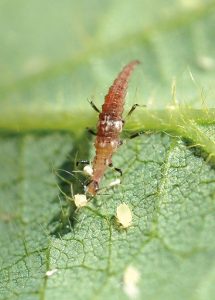
Here, a lacewing larva eats aphids. Like lady beetles, lacewings have voracious appetites. Photo courtesy Thelma Heidel-Baker
Types of Biological Control
Biological control, the use of living organisms to provide pest control, can take a number of different forms. Classical biocontrol involves the widespread release and establishment of a nonnative natural enemy from the pest’s native range. This method is generally managed by government agencies and scientists and can lead to long-term pest reduction. Unfortunately, classical biocontrol requires an immense amount of testing and vetting, so the process can be very slow. And even with all the careful vetting, there have been instances of classical biocontrol going very wrong and producing unintended ecological and economic consequences. Who can forget the cautionary tale of the cane toad in Australia?
Another form of biological control, referred to as augmentative biocontrol, involves the purchase and release of mass-reared insects. This method can be very effective in greenhouses or confined spaces, and can provide at least temporary relief from pest pressure. The drawback is that augmentative biocontrol often doesn’t provide long-term pest control, as released populations of beneficial insects won’t establish permanently without habitat and management.
The magic of conservation biocontrol is that it works within existing ecosystems and relies on natural processes. Unlike other forms of biological control, CBC doesn’t rely on the introduction of foreign agents to do the job; it uses wild insects that are likely already present. In a way, it is the oldest of pest control systems made modern. Conservation biocontrol focuses on creating habitat and adopting farming practices that support beneficial insect populations. Since the estimated value of pest control by wild beneficial insects is $4.5 billion to $12 billion annually for U.S. crops, and $100 billion worldwide, it is a method that seems to be working.
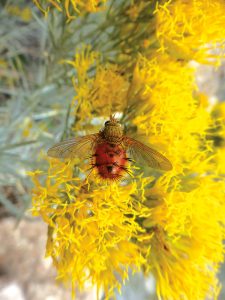
This tachinid fly is a parasitoid, which lays its eggs on or inside the body of its host. Photo courtesy Sarah Foltz Jordan
Importance of Habitat
Habitat is the key ingredient in conservation biocontrol, primarily because flowering plants provide food by way of pollen and nectar. Many beneficial insects rely on pollen or nectar at specific periods of their life cycle, or use these floral resources to supplement their diets when insect prey is not available. For example, syrphid flies are predaceous in their immature stage, but feed exclusively on nectar as an adult. Adult lady beetles, on the other hand, need to feed on a combination of insect prey, pollen and nectar to flourish. Carefully placed and managed habitat can also provide nesting and overwintering sites and a refuge from pesticides and disturbances such as tillage or heavy equipment use.
On-farm habitat for beneficial insects can take many different forms. It can be as simple as allowing crops to bolt at the end of the season (as was successful on Lucas’ farm), or it can be planting a permanent hedgerow of blooming shrubs and perennials along a field border or roadside. Insectary strips of blooming plants in the middle of a field can support beneficial insects throughout large cropped areas, as can seasonal cover crops. Beetle banks, comprised of a raised bed of bunch grasses, can provide shelter for large populations of predaceous ground beetles.
There are a few basic principles to keep in mind. Having somewhere on a farm with permanent habitat that is well protected from pesticides is critical for maintaining populations of beneficial insects on a farm long-term. Also, providing consistent floral resources from early in the spring all the way into the fall is an important way to support a diversity of natural enemies throughout their life cycles.
Scientific data supports the key function of habitat in conservation biocontrol. For example, a recent study comparing stink bug parasitism in tomato fields adjacent to hedgerows and tomato fields without habitat, found that parasitism rates were three times as high in fields adjacent to hedgerows. Another study found that planting buckwheat as a flowering cover crop adjacent to soybeans increased wasp parasitism of stink bug eggs by two and a half times.
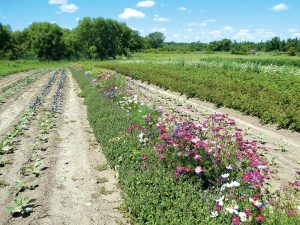
An insectary strip of blooming plants in the middle of a field supports beneficial insects throughout the cropped area. Photo courtesy Sarah Foltz Jordan
Case for Conservation Biocontrol
Conservation biocontrol can work in nearly any cropping system and with many different pests. For example, predatory ground beetles attack soil-dwelling pests such as caterpillars, tuberworms and cutworms. Predatory mites, minute pirate bugs and lacewings can decimate populations of two-spotted mites and thrips. Finally, aphids are a favorite food of almost all beneficial insects, including amazing parasitoid wasps.
The only real cost of conservation biocontrol is in establishing and managing the habitat that supports beneficial insect populations, and agencies such the USDA’s Natural Resources Conservation Service (NRCS) can help pay for that.
There’s no reason not to practice conservation biocontrol. Just ask Lucas.
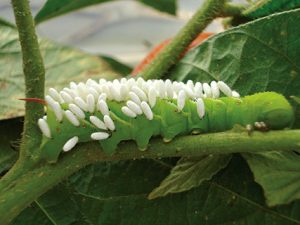
Pictured is a parasitized tomato hornworm, with the parasitoid’s eggs laid on the outside of the host’s body. Photo courtesy Thelma Heidel-Baker
Author’s note: For more information about planting habitat for beneficial insects, contact your local NRCS field office, or Jessa Kay Cruz at jessa.cruz@xerces.org.
